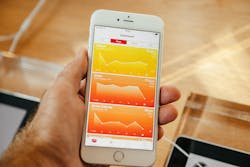The recent meaningful use Stage 3 proposal that calls for more that 15 percent of patients to contribute patient-generated health data (PGHD) or data from a non-clinical setting into the certified electronic health record (EHR) technology during the EHR reporting period, will put the onus on providers to collect information from patients who use home medical devices.
Data gathered from consumer-owned fitness trackers also have the potential to be incorporated into the health record; recently, eClinicalWorks, a Westborough, Mass.-based ambulatory EHR vendor, announced that it has begun to integrate data from wearable devices, from such devices as the Fitbit, iHealth, Jawbone and Withings, into its Health & Online Wellness personal health record. For most vendors and provider organizations, however, this concept is a novel one.
To this end, at the 2015 Healthcare Information and Management Systems Society (HIMSS) conference in Chicago, the Durham, N.C.-based Duke Medicine shared the experience it has had thus far with Apple’s HealthKit, a health platform Apple launched last year that aimed to connect personally-generated health data and clinical data. Since HealthKit’s launch, many notable healthcare organizations, including Stanford Medicine, Cleveland Clinic, and EHR vendors like Epic, have all partnered with Apple to work in their own patient-generated data applications. At Duke, Ricky Bloomfield, M.D., director, mobile technology strategy, led the effort to integrate Apple's HealthKit and also the effort to integrate the SMART on FHIR (Fast Healthcare Interoperability Resources) platform at the organization, being the first Epic hospital to accomplish that feat.
At HIMSS15, in front of an inquisitive audience at the McCormick Place Convention Center on April 15, Bloomfield gave an overview of how Duke is using HealthKit to get patient-generated data into the EHR. Bloomfield said the idea began gaining steam about a year ago when multiple providers at Duke expressed interest in wanting to get PGHD into the EHR. “Everyone was having this problem, and there wasn’t a great solution,” Bloomfield admitted. He noted that cardiologists and oncologists were asking Duke’s IT people what could be done to get patient data into the medical record as a way to avoid readmissions. “I was honest at the time, and I told them I had no tools for them,” said Bloomfield.
At the time, he said, there were rumors about Apple launching something, and then in June 2014 when it released HealthKit, Bloomfield saw it as a potential solution to Duke’s—and other provider organizations’—problem. Bloomfield noted that the project required the cooperation of Epic, and they were happy to see that the vendor became an early partner with Apple. “We were in a good position to take advantage of Epic right away. We dove right into HealthKit once it became available, and got it working in a few weeks. It was a real testament to the work that Epic did,” Bloomfield said. Currently, he added, the initiative is still considered a pilot, with less than 50 patients and providers participating.
Getting the Data Integrated
For providers at Duke, the first step to getting the data integrated with their medical records involves asking patients if they want to share their information, said Bloomfield. “Patients cannot unilaterally enter their data into the EHR, and that’s by design. There simply is no way for providers to handle that mass intake of data right now,” he said. As such, the provider enables HealthKit for patients right now, and the provider has a flow sheet that keeps the patient-generated data separate from other data in the system, Bloomfield said. This way, you can still do analytics on it, but it’s separate from other clinical data, he said.
The providers are then asked for permission to access the data, and when that permission is granted, the data comes through the portal into the EHR. Such data can be from activity trackers, blood pressure devices, glucose monitoring, and many other devices, Bloomfield noted. While on the surface it might seem like a lot of data is being integrated with activities as simple and frequent as “steps,” Bloomfield said the ability for providers to set how often they want to be notified about the data has been built into the system. “They get messages to their convenience, whether that’s once a day, once a week, or never,” he said. “We believe providers won’t choose ‘never’ obviously, but it’s not something we have dictated to them. We are leaving it up to them; we don’t want it to be a burden. It might vary by clinic and provider too. It’s really all up to them.”
Regarding privacy/security, a huge issue when it comes to patient-generated data, Bloomfield said that the design puts control of the data in the hands of patients directly. “They can turn it off at any time in Epic’s MyChart. Our goal is to make it clear that they have that control. They can share it with other vendors, apps, healthcare systems that integrate with HealthKit, or with us,” he said.
What’s more, at Duke, a modified consent for the MyChart app was created, but points were added so that patients were sure to understand it all, Bloomfield noted. “Will they read all the fine print? That’s an open question for sure. When we get data from them, we cannot guarantee that we will view and act on it in real time. This is evolving technology, and we might find that it is so reliable that we can act on a measure of 180/120 blood pressure levels and intervene immediately. Now is not that time though, as we can’t be sure of the reliability of the data,” Bloomfield said, adding that if providers do see concerning values, they will alert the patient to seek medical attention. “We don’t want to give patients a false of security,” he said.
And to that end, the HealthKit app does give ranges of normal values, with Apple’s new iOS update, something Bloomfield called “a bold move.” But the intent is to put patient safety first, he said. “If they see a value in the red, it gives them an opportunity to reach out to a provider, be engaged, and be involved in their own care. The more invested patients are in their care, the better the outcomes,” Bloomfield said.
Moving forward, Bloomfield noted, the biggest issue is the management of the devices. “Right now, we're not providing patients with devices to do this. As soon as you get into that business, you have to provide support too, which requires work with the legal department,” he said. “Is giving a device coercive? Because that’s not what we’re going for.” Bloomfield maintained that Duke is not trying to move faster than it should, noting the high expenses associated with devices that have HealthKit enabled. “Connectivity at home is also a big issue for us,” Bloomfield said. High-risk populations are most likely to have bad internet connections at home, if they have any at all. “What’s our responsibility to help with that? That’s another open question right now,” he said. “In the future my vision is to partner with the payers, demonstrate efficacy and increase efficiency, at which point the payers will subsidize those device costs.”


